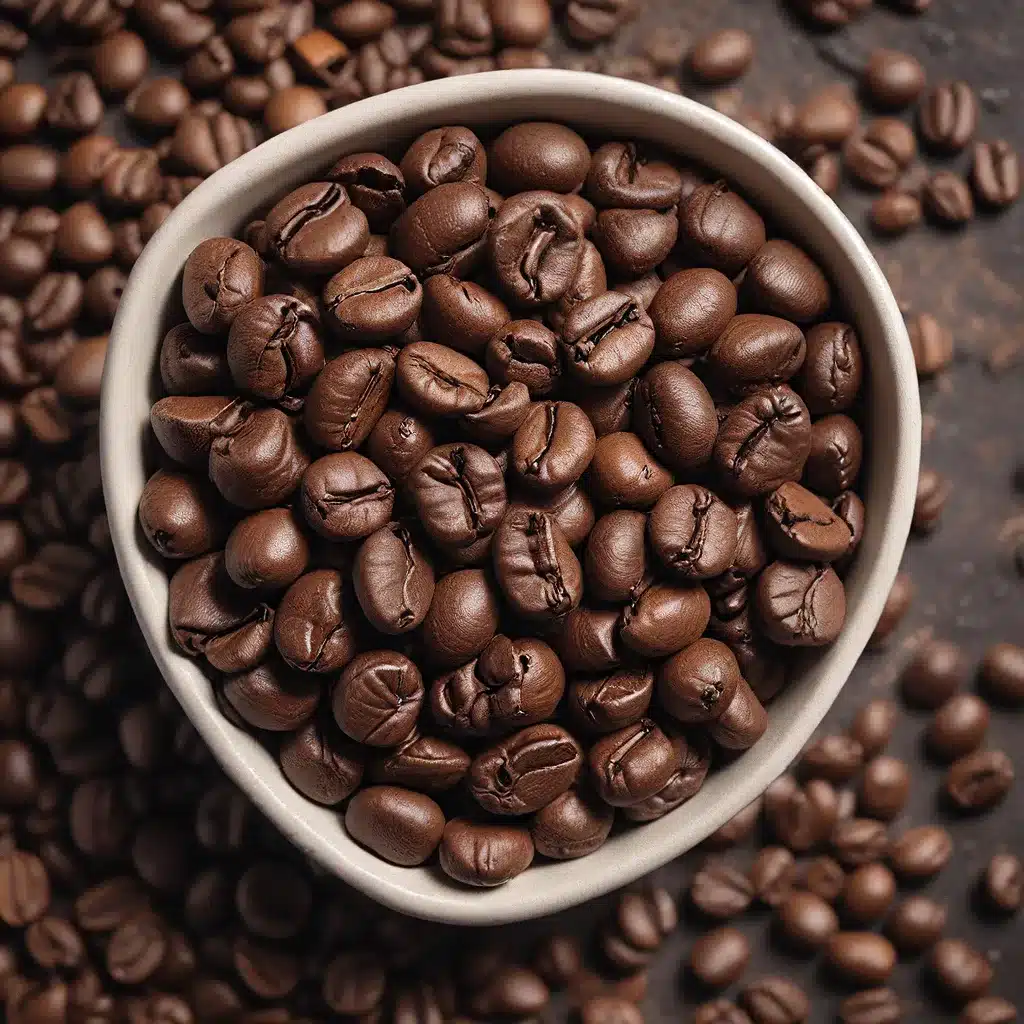
Ah, the humble coffee bean – the elixir that kickstarts my day and has become an integral part of my morning routine. But have you ever wondered about the fascinating journey these little flavor capsules take before they end up in your cup? As a self-proclaimed coffee addict, I’ve been on a quest to uncover the secrets behind the diverse and captivating world of coffee.
Uncovering the Origins of Coffee
It all starts with the cultivation of those unique coffee cherries, nestled in landscapes as diverse as the beans they produce. Each coffee cherry contains the beans that, once harvested, are packaged and ready for their next destination. The labels on these coffee bags serve as an informative roadmap, guiding us through the coffee’s journey and shedding light on its origins.
You see, traceability is crucial in the coffee industry – it’s like a detective story, where every clue brings us closer to the source of our beloved brew. By understanding the origins of our coffee and who has grown it, we can forge a stronger connection to the product, enhancing the overall coffee experience. And with the rise of blockchain technology, some coffee companies are now providing even greater transparency within the traditionally opaque supply chain.
As I delve deeper into the world of coffee, I’ve come to appreciate the unique characteristics of these beans. It’s fascinating to learn that coffee beans grown at higher altitudes often exhibit brighter, more complex flavor notes, akin to the high notes in a symphony. These beans, sometimes labeled as SHB (Strictly Hard Bean) or Altura, can offer delightful fruity and berry-like flavors. On the other hand, lower-altitude coffee tends to have a more mellow and smooth taste, with a deeper, richer profile – the bass line to the high-altitude coffee’s melody.
Unraveling the Art of Roasting
But the story of coffee doesn’t end with its origins – the magic truly happens during the roasting process. It’s like a chef expertly cooking ingredients to bring out their best flavors. The skilled coffee roasters apply heat to the green coffee beans, carefully controlling the timing and temperature to reveal the full potential of the beans.
This roasting process results in a spectrum of roast levels – light, medium, and dark – each producing a distinct color and flavor profile in the coffee beans. Understanding these roast levels is like having a secret key to unlocking a world of flavors that match your personal preferences.
Let’s dive into these roast levels, shall we? Light roast coffee is like the morning person of the coffee world – bright, energetic, and full of zest. Recognized by their light brown color and the absence of oil on the surface, these beans are roasted to an internal temperature of about 350°-410°F, where they reach the light roast level at the first crack near 350°F. What makes light roast coffee so delightful is its bright, crisp, and lively flavor profile – perfect for those who love a refreshing and invigorating start to their day.
If light roasts are the morning people, then medium roasts are the all-rounders, striking a balance between the bright flavors of light roasts and the richness of dark roasts. Roasted just before the second crack between 410°-440°F, medium roast coffee beans exhibit a brown color and a body that is thicker than light roast but not as heavy as dark roast, offering a pleasing tactile experience. These medium roasts showcase sweet notes like caramel and nougat, creating a harmonious balance of flavors. Often referred to as American Roast, Breakfast Roast, or City Roast, medium roasts are a fantastic gateway for those transitioning from dark roasts.
And then there’s the night owl of the coffee world – dark roast coffee. Shade-grown coffee beans, especially those with a dark roast, display a dark brown to nearly black color and a characteristic glossy surface from the oils released during roasting. Roasted beyond 440°F, these beans offer a bold and smoky flavor profile with notes of chocolate, toasted nuts, and hints of spice. The full body of dark roast coffee is defined by flavors such as chocolate, caramelized sugars, and roasty notes, contributing to its richer taste profile. If you’re someone who loves a robust coffee experience, dark roast coffee is your perfect match.
Exploring the Art of Coffee Processing
As if the journey of coffee beans couldn’t get any more fascinating, let’s dive into the world of coffee processing techniques. This is where the magic truly happens, where the raw green coffee beans are transformed into the flavorful beans we know and love.
There are three basic coffee processing methods: fully washed, honey, and natural. Each of these methods offers a unique flavor profile, and understanding them is like getting a behind-the-scenes tour of the coffee world, revealing how the flavors in your cup are crafted.
In the washed process, the coffee yields a clean and bright cup with pronounced acidity. The natural process, on the other hand, brings out fruity and complex flavors. And the honey process imparts a unique sweetness to the coffee.
It’s like a choose-your-own-adventure for coffee enthusiasts, where each processing method offers a distinct and delightful experience. And as I continue to explore the nuances of these techniques, I find myself constantly amazed by the level of care and attention that goes into every step of the coffee-making process.
Navigating the World of Coffee Certifications
But the story of coffee isn’t just about flavors and aromas – it’s also about the people behind the beans, their livelihoods, and the environment. That’s why I pay close attention to the various certifications and sustainability claims that adorn the coffee bags I come across.
Certifications like Organic, Fair Trade, and Rainforest Alliance are like seals of approval, vouching for the ethical and environmentally friendly practices behind the production of my coffee. These certifications foster ethical trade, empower producers, improve livelihoods, and ensure fair pricing. They also protect the environment by prohibiting harmful agrochemicals and deforestation. Navigating these certifications is like reading a story of sustainability and ethics, providing me with a glimpse into the coffee industry’s commitment to responsible practices.
As I sip my coffee, I can’t help but feel a deeper connection to the journey it has taken – from the hands of dedicated farmers to the roasters who have meticulously crafted its flavor profile. And by understanding the significance of these certifications, I’m able to make more informed choices that not only satisfy my taste buds but also align with my values.
Unlocking the Language of Tasting Notes
Speaking of flavor profiles, let’s talk about the tasting notes that often adorn the coffee bags I come across. These flavor descriptions are like a roadmap, guiding me through the unique taste experience that awaits me. From fruity and floral overtones to rich chocolate and toasted nut notes, these tasting notes are the key to unlocking the diverse world of coffee flavors.
The Coffee Tasters’ Flavor Wheel has been an invaluable tool in helping me navigate this flavor landscape. It’s like learning a new language, one that allows me to articulate and appreciate the nuances of each cup of coffee I savor. And as I continue to refine my palate and expand my flavor vocabulary, I find myself constantly amazed by the depth and complexity that can be found in a simple cup of coffee.
Freshness: The Cornerstone of a Remarkable Coffee Experience
Of course, no discussion of coffee would be complete without addressing the importance of freshness. After all, the roast date – that timestamp of when the coffee was roasted – is the best indicator of a coffee’s freshness and a key determinant of its flavor.
I’ve learned that optimal freshness and flavor are typically achieved when coffee is consumed within a 7 to 21-day period after roasting. The best-by date, on the other hand, suggests when the coffee should be ideally purchased or used. While coffee beans don’t become harmful after the best-by date, they can start to taste stale. Proper storage, however, can preserve their usability and prolong the freshness of the beans.
Ensuring I purchase freshly roasted coffee and store it properly has made all the difference in my coffee-drinking experience. Gone are the days of settling for stale, lackluster brews. Now, I savor the vibrant, complex flavors that only truly fresh coffee can deliver.
Exploring the World of Specialty Coffee
As my coffee journey has progressed, I’ve become increasingly drawn to the world of specialty coffee. This category surpasses the standard offerings, aiming for the highest quality and emphasizing the unique characteristics and origins of the beans. It’s like the VIP section of the coffee world, offering a luxurious experience that’s all about quality, sustainability, and unique flavor experiences.
The excellence in specialty coffees’ flavor profile arises from a careful attention to detail throughout the cultivation, harvesting, processing, and roasting stages. Through transparency, growers are incentivized for the quality of their coffee, moving away from the volatility of commodity market prices. And specialty coffee roasters often favor lighter roasting to preserve and highlight the unique flavors indicative of the coffee’s origin.
As I sip my way through the diverse offerings of the specialty coffee realm, I’m continuously awed by the rich tapestry of flavors and aromas that these beans can deliver. It’s like a symphony of taste, with each cup offering a unique and captivating performance.
Celebrating the Diversity of Coffee Varieties
And let’s not forget about the incredible diversity of coffee plant varieties. The coffee plant is a marvel of nature, with countless varieties, each offering its own unique set of flavors and aromas. Coffea arabica and Coffea canephora (Robusta) are the two most well-known species, with the former originating in Ethiopia and South Sudan, and the latter in sub-Saharan Africa.
Within the Coffea arabica species, there are various cultivars, such as Typica and Bourbon, each with different characteristics and origins. These varieties significantly influence the spectrum of flavors, aromas, and other characteristics found in the final roasted product.
Knowing about these varieties is like getting a glimpse into the genetic blueprint of my coffee, revealing the rich diversity that shapes its taste and aroma. It’s a testament to the incredible complexity and nuance that can be found in this humble little bean.
Embarking on a Continual Journey of Discovery
As I reflect on my coffee journey, I’m struck by the sheer depth and complexity of this beloved beverage. From the origins of the beans to the art of roasting, the intricacies of processing, and the significance of certifications and sustainability, there is always more to uncover and explore.
And with the rapid pace of innovation and research in the coffee industry, I know that my understanding of this captivating world is ever-evolving. Sips Coffee House has been an invaluable resource, providing me with the knowledge and inspiration to continually expand my coffee horizons.
So as I raise my cup to the aroma-filled air, I can’t help but feel a sense of wonder and excitement. There’s always a new flavor profile to discover, a different processing method to explore, or a unique variety to savor. The journey of coffee is one that I am thrilled to be a part of, and I can’t wait to see what new adventures await me on the road ahead.















